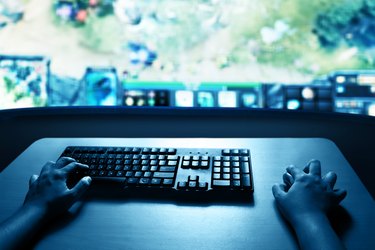
Dolphin is an open-source emulator, used to play Nintendo GameCube, Nintendo Wii, and Nintendo Wii U games on a PC. The emulator allows users to play games with enhanced visuals and other performance tweaks, allowing for experiences even better than those available when playing on a real game console – but not every computer can take advantage of all of Dolphin's features. In certain games, this can manifest as a low frames per second (FPS) count, leading to lag and visual stuttering during gameplay. In Dolphin, low FPS issues may be solved by tweaking graphics settings.
Dolphin Low FPS Problems?
Video of the Day
Though the Dolphin emulator is built to play games released on older consoles – games that may be anywhere from five to nearly 20 years old at this point – the emulator cannot run adequately on every computer available on the market today. In part, this is because not every game it emulates behaves in the same way: certain games demand far more from the system running it than others. For example, some games run properly in the Dolphin emulator at 60FPS, while others run properly at a consistent 30FPS. If a game running in Dolphin demands more than the system can give, it can lead to a reduction in FPS. This will cause the game to slow down, and can result in hitching, strange or distorted audio and other problems that can hinder the gameplay experience. As a result, each game emulated in Dolphin may require you to adjust the emulator's system settings, in order to ensure a smooth and enjoyable experience.
Video of the Day
Tweaking Dolphin Settings
More often than not, solving a low FPS issue in Dolphin can be accomplished by adjusting graphical settings within the emulator. However, before adjusting any settings you should close any additional programs or windows open alongside Dolphin: the emulator is demanding even on a high-powered system, and because it uses a computer's CPU more than the video card, running other intensive programs at the same time can cause a reduction of FPS.
Once Dolphin is running on its own, you can adjust the graphics settings by clicking the "Graphics" tab in the main emulator menu. In the window that appears, you can toggle enhancements and other visual features, as well as adjust aspect ratios and resolutions. Turning off features such as V-Sync and Anti-Aliasing, in addition to lowering the display resolution can help to increase FPS (though this may come at the cost of visual fidelity). Changing the backend from DirectX to OpenGL may help in certain games. Once you've adjusted your settings, you may close the window and boot up your game of choice: with luck, your game should now run at a higher, consistent FPS. However, certain games emulate with some degree of slowdown regardless of settings. If this fails to work, it may also help to adjust the size of the window the game is running in. In Dolphin, an increase in FPS often follows when the screen size is reduced, as the emulator can render the game at a lower resolution.
System Hardware Issues
If modifying your graphics settings fails to solve the problem, even when Dolphin is the only program running on your computer, you may need to upgrade your hardware to adequately play your desired game. Though it can be disheartening, particularly when using a laptop that cannot be fully upgraded, Dolphin is a CPU-intensive emulator: system recommendations suggest using a quad-core CPU, and the emulator needs a dual-core at minimum to function. If your system cannot meet the minimum requirements demanded by the emulator and a game, you will have to either upgrade your system or endure the reduced FPS.